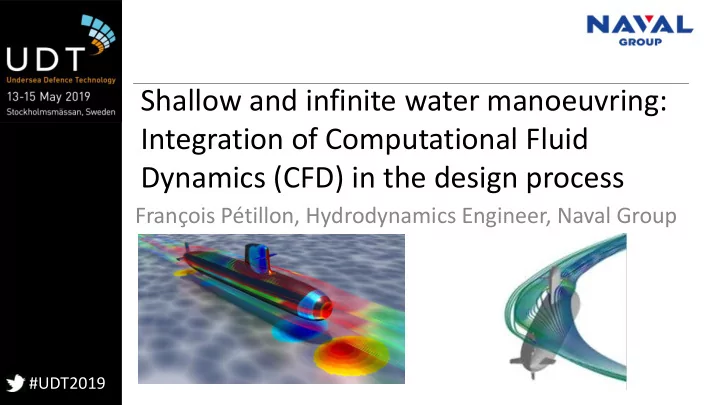

Shallow and infinite water manoeuvring: Integration of Computational Fluid Dynamics (CFD) in the design process François Pétillon, Hydrodynamics Engineer, Naval Group #UDT2019
Summary 1. Integration of CFD within design process 2. CFD based methods for manoeuvring performances evaluation 3. Validation of CFD methods – Infinite water 4. Constrained and shallow water particularities #UDT2019
Summary 1. Integration of CFD within design process 2. CFD based methods for manoeuvring performances evaluation 3. Validation of CFD methods – Infinite water 4. Constrained and shallow water particularities #UDT2019
Integration of CFD within design process Submarine manoeuvrability study deals with several topics : • Operational capability • Turning capability • Diving capability • Controllability • Navigation safety • Submarine behaviour in case of hydroplane failure or flooding • Control surfaces and actuator design • Structural design to withstand hydrodynamic forces • Capacity of the actuators Purpose of manoeuvrability studies are : • External shape design • Performances verifications #UDT2019 • Risk management
Integration of CFD within design process Different tools can be used in hydrodynamics studies, in infinite depth or constrained water • Preliminary tools • Computational Fluid Dynamics • Free running physical model • Complementary tools #UDT2019
Integration of CFD within design process Design for manoeuvring capabilities : standard design phase #UDT2019
Summary 1. Integration of CFD within design process 2. CFD based methods for manoeuvring performances evaluation 3. Validation of CFD methods – Infinite water 4. Constrained and shallow water particularities #UDT2019
CFD methods for submarine manoeuvrability The calculation method was defined to be : • Fully qualified against reference data • Reliable • Efficiently applicable to the design needs The construction of the method was performed in 3 steps : 1. Definition of a calculation setup 2. Verification of setup convenience to the whole range of studied cases 3. Embedment of method into an automated #UDT2019 process
CFD methods for submarine manoeuvrability Captive simulation modelling : • Similar approach to captive model tests • Steady state flow on submarine, in a set of various configuration • Straight course, drift, incidence, vertical and horizontal turns, rudders and hydroplanes angles • Evaluation of the efforts on submarine and stock torque on hydroplanes Free running simulation modelling : • Simultaneous solving of hydrodynamic flow and submarine movement • Reproduction of steady state trajectories of reference manoeuvres : • Turning with rudder angle • Vertical and horizontal dynamic stability (turning with 0 ° hydroplane angle) • Trim change #UDT2019
Summary 1. Integration of CFD within design process 2. CFD based methods for manoeuvring performances evaluation 3. Validation of CFD methods – Infinite water 4. Constrained and shallow water particularities #UDT2019
Validation of CFD methods : infinite water Validation strategy : 2 types • Sea trials records • Model tests measurements The origin of the reference validation result depends on the considered characteristics: • For manoeuvring performances, the values determined from the submarines sea trials are considered • For the evaluation of forces on rudders and linear manoeuvring coefficients, model scale captive model tests results are considered #UDT2019
Validation of CFD methods : infinite water Validation synthesis of captive simulation • Validation process includes 6 main submarines • Comparison made between CFD results and validation cases shows a good agreement Examples of comparisons : Hydroplane Pure vertical efficiency rotation Z force Y moment Drift Stock torque coefficient Y force #UDT2019
Validation of CFD methods : infinite water Validation synthesis of free running simulation • Turning rate submerged with extreme rudder angle were computed for 3 submarines • The comparison between CFD results and sea trials data gives an assessment of main manoeuvring characteristic (diameter of trajectory) • Less than 5% difference is found #UDT2019
Summary 1. Integration of CFD within design process 2. CFD based methods for manoeuvring performances evaluation 3. Validation of CFD methods – Infinite water 4. Constrained and shallow water particularities #UDT2019
Constrained and shallow water particularities When navigating in constrained and shallow water, supplementary hydrodynamic efforts are to be taken into account. This may affect : • Autopilot optimisation • Safe operating envelope definition To take into account shallow water specificities in submarine design : • Model tests close to bottom can be made, but are difficult to realise and insufficient • For submarine design, Naval Group developed a complementary set of computation methods: • Simplified method based on Boundary Element model, for parametric studies and optimisation on a wide range of situation • CFD calculation, for specific operational cases validation #UDT2019
Constrained and shallow water particularities Flat sea bottom example : validation of simplified method VS CFD calculations Comparison of Naval Group CFD with existing literature on submarines : #UDT2019
Conclusion • The current process for submarine manoeuvrability assessment fully integrates CFD methods • These CFD methods were developed and applied by Naval Group for the past decades, and validated by comparison with sea trials and model tests on several seagoing submarines • Constrained and shallow water manoeuvrability can be handled more accurately through these methods o Allows reduction of navigation margins and optimisation of autopilot #UDT2019
THANK YOU FOR YOUR ATTENTION #UDT2019
Recommend
More recommend